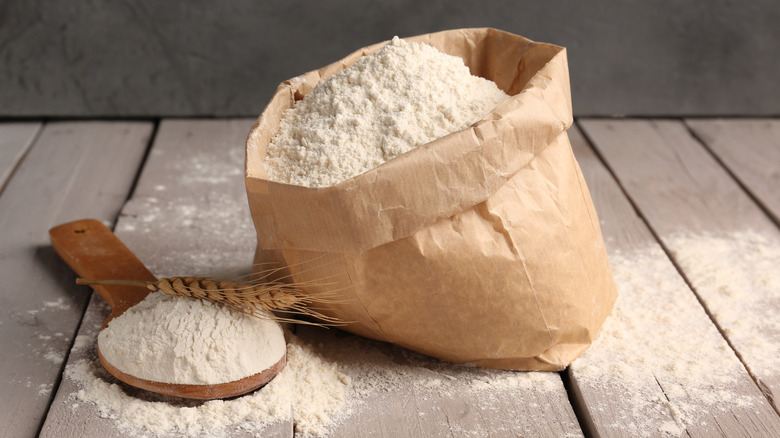Here's Why Flour Is Always Sold In Paper Bags Not Plastic
Many foods you consume today may look very different than they did decades ago. As years go by, many brands update their products' packaging to cut costs or make the items appear sleeker and more appealing to the modern shopper. However, all-purpose flour has seemingly been sold in those simple paper bags since the dawn of time. In reality, paper flour bags were introduced in the 1920s and popularized in the '40s. So how come flour producers haven't switched things up after all these years?
A big reason these bags remain is the material's breathability. Contrary to what some folks may believe, flour can go bad. Your nose will tell you if the product has gone rancid. (Changes in appearance and texture are good indicators as well.) Spoilage may take a year, depending on the type of flour, with all-purpose lasting the longest. However, the process can be expedited without proper storage. If there's moisture present, it can certainly cause flour to form clumps or mold. Selling the ingredient in paper bags ensures that any moisture left over from the milling process has the chance to evaporate before damaging the product.
Paper first, but not forever
Flour wasn't always sold in paper bags. Until the turn of the 20th century, it was typically sold in white pine barrels. However, it cost more to freight the stuff around the country when it was stored in heavy wooden receptacles. With the invention of the sewing machine in the 19th century, it eventually became more economical to sell flour in cotton sacks. The sacks, produced mostly by women, also made excellent marketing material for the milling companies. Folks loved them, particularly in rural areas, because they could be repurposed to make clothes, dish towels, blankets and other household items. (It's similar to how Costco shoppers come up with creative ways to use leftover rice bags.) But by the 1940s, it was paper all the way.
Switching to paper flour sacks significantly cut production costs once again. Because this packaging also allowed people to buy smaller amounts of flour, it was more reasonable for folks to find their own airtight storage container that would easily fit in their kitchen. While the paper sack allows for necessary air circulation to dispel moisture after from milling, transferring flour to an airtight container — like a glass jar — is recommended for long term storage.

